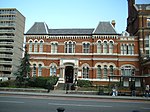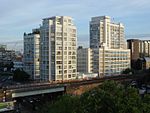Heygate Estate
1974 establishments in EnglandDemolished buildings and structures in LondonHousing estates in the London Borough of SouthwarkResidential buildings completed in 1974

The Heygate Estate was a large housing estate in Walworth, Southwark, South London comprising 1,214 homes. The estate was demolished between 2011 and 2014 as part of the urban regeneration of the Elephant & Castle area. Home to more than 3,000 people, it was situated adjacent to Walworth Road and New Kent Road, and immediately east of the Elephant & Castle road intersection. The estate was used extensively as a filming location, due in part to its brutalist architecture. The clearance of the site and its sale to Lendlease for redevelopment was highly controversial.
Excerpt from the Wikipedia article Heygate Estate (License: CC BY-SA 3.0, Authors, Images).Heygate Estate
Ash Avenue, London Elephant and Castle (London Borough of Southwark)
Geographical coordinates (GPS) Address Nearby Places Show on map
Geographical coordinates (GPS)
| Latitude | Longitude |
|---|---|
| N 51.493055555556 ° | E -0.096111111111111 ° |
Address
Elephant Springs
Ash Avenue
SE17 1AZ London, Elephant and Castle (London Borough of Southwark)
England, United Kingdom
Open on Google Maps







